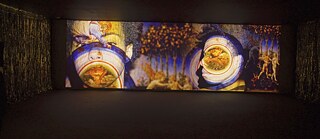Artist Presentation
Theo Eshetu: Reflections on the Lives of Objects

In conversation with Katharina von Ruckteschell-Katte
On this special evening, Theo Eshetu, artist in residence at the Goethe-Institut London, will give an informal presentation of his works, an occasion to view and discuss some of his more celebrated video installations: The Return of the Axum Obelisk, Atlas Fractured and Ghost Dance.
The residency is part of the transcultural research and artistic project Lives of Objects*, set up by the Goethe-Institut, which aims to harness ongoing conversations and exchange around the themes of decoloniality and restitution – working with researchers, artists, and museum professionals, the project situates cultural heritage objects at its centre. Berlin-based multimedia artist Theo Eshetu’s most recent film The Moving Museum closely followed the formation of the controversial Humboldt Forum. During his time here, he is working with experts from the Victoria and Albert Museum and the museum collections.
In the works that will be shown at the event, Eshetu engages with questions of restitution of artifacts, museology, and cultural identities. Using a visual language reminiscent of traditional iconoclastic paintings and electronically fractal images, his multimedia works are complex, stratified multiscreen video pieces, not only in form but also in content, bringing together mythological, religious, political, and aesthetic issues that address the sociopolitical realities of our time. For his upcoming film The Moving Museum Eshetu has spent six years filming in and working with the Humboldt Forum and the Museums of Ethnography and Asian Art in Berlin.
*The first project phase, entitled Practicing Freedom, was curated by Amal Alhaag and Selene Wendt – see https://goethe.de/uk/practicingfreedom
Book tickets via Eventbrite
Screening programme:
The Return Of The Axum Obelisk
2009, extract 10 minutes
The Return of the Axum Obelisk is inspired by traditional Ethiopian paintings that narrate the legend of the Queen of Sheba. Her story is at the basis of Ethiopia’s origin myth.
It is a work that celebrates the historic event of the restitution of a 25-meter, 160-ton stele that was brought to Rome as a war trophy during the Italian occupation. The filming of the process from its dismantling in Rome to its transport to Axum and the subsequent process of re-mounting, until the final celebrations are the visual basis for the work. The installation transforms the symbolic significance of the obelisk from an object representing victory and loss to becoming a post-colonial symbol of peace, reconciliation, and unity.
Atlas Fractured
2017, 18 minutes
Atlas Fractured was created for documenta14 and projected on a very large Museum banner in Kassel. The more intimate Athens version is a hauntingly beautiful and poetic reflection of a fragmented world. Made through the projection of paintings sculptures and films onto real live models the video explores mythologies and art history to address the ineffable power of existence.
The fragmented soundtrack combines quotes from Carl Jung, James Baldwin, Langston Hughes, Toni Morrison, Maya Angelou, Angela Davis, Joseph Campbell, Andy Warhol, Bertrand Russell, Homi Bhabha, Charlie Chaplin, and many more with an equally eclectic compilation of music from around the world held together by a sound design composed by Keir Frazer.
Ghost Dance
2020, 18 minutes
Video installation commissioned for the Gwangju Biennale, 2020
Shot on the worksite of the Humboldt Forum and the Museums of Ethnography and Asian Art in Dahlem, Ghost Dance (2020) looks at the relations between the ethnographical display of the museum collections and the choreographing of their metaphorical death and life as they enter the museum space. What does it mean for objects to possess subjectivity in representing spheres of life and social bonds? This question circulates through the bodies of two exceptional dancers, who channel kinetic energy as a repository of spirit objects and rituality.
As the dancers step into the roles of objects and migrate from one space to another, from one cultural context to the next, Eshetu taps into the ongoing debate around the restitution of looted goods from colonised territories. Ghost Dance temporarily releases the hegemonic museum from its linear narrative into the realms of the polyphonic and the unexpected.
Theo Eshetu
Theo Eshetu has worked in media art since 1982 exploring various formats from essay-films to large-scale video installations that explore how electronic media shape and inform global perceptions. His works present formal aesthetic research with a specific engagement with the interconnectedness of world cultures.
Shown in international art exhibitions including Snap Judgments, Die Tropen, and Sense of Time, he was present at numerous biennales including Venice, Kochi-Muziris, Ireland, Shanghai, Gwangju, Dakar and more. Eshetu was the recipient of the DAAD Artists-in-Berlin scholarship 2012 and participated in documenta 14. Currently his groundbreaking installation from the 1980s, Till Death Us Do Part, is on show at MoMA. He lives and works between Berlin and Rome.